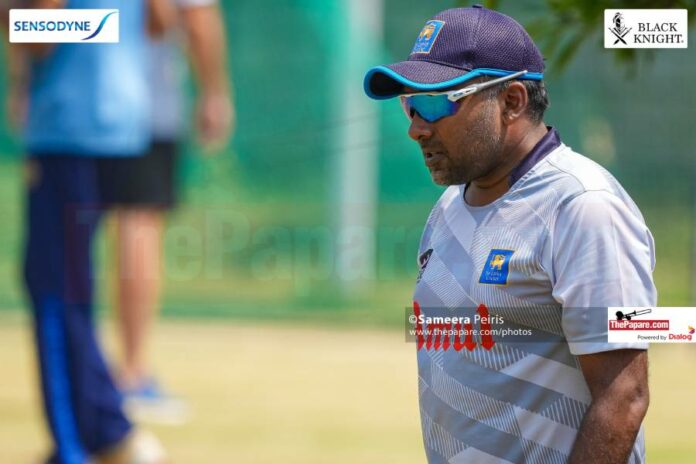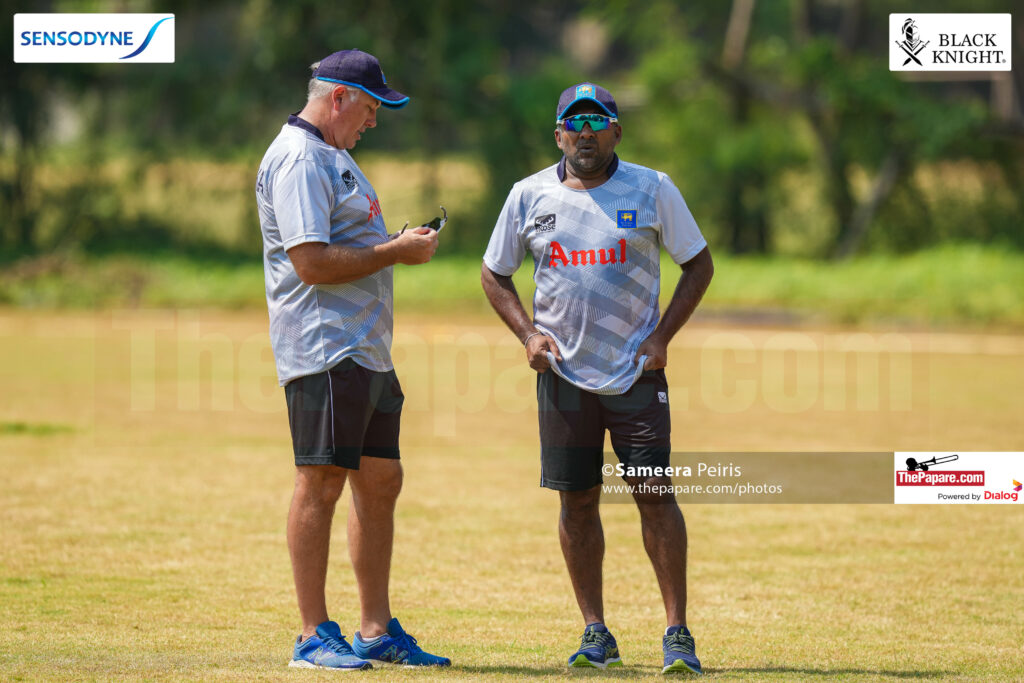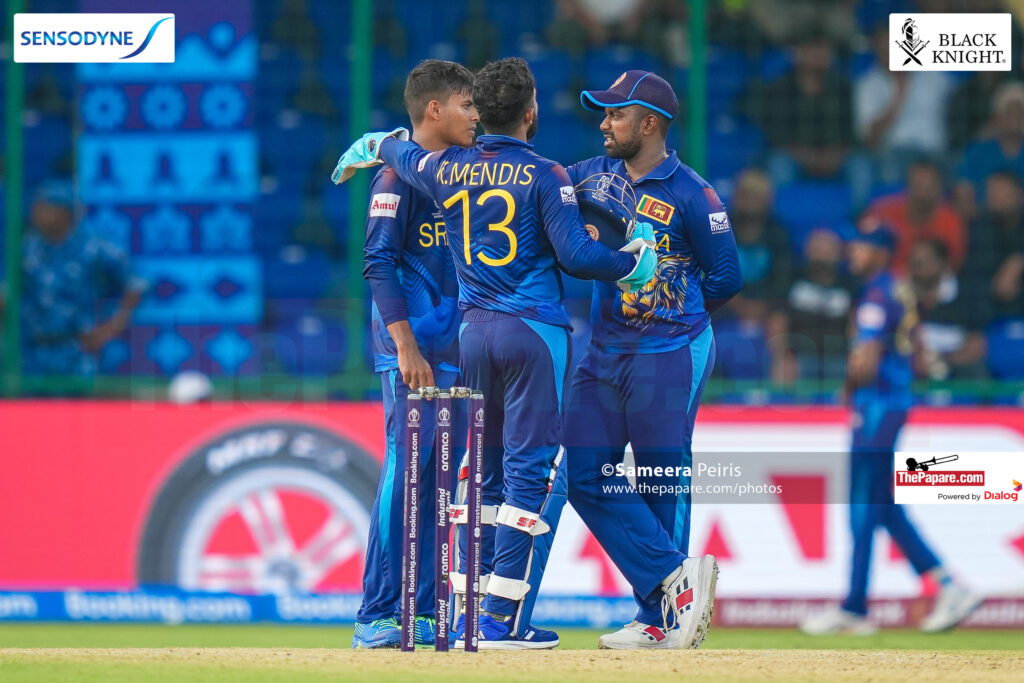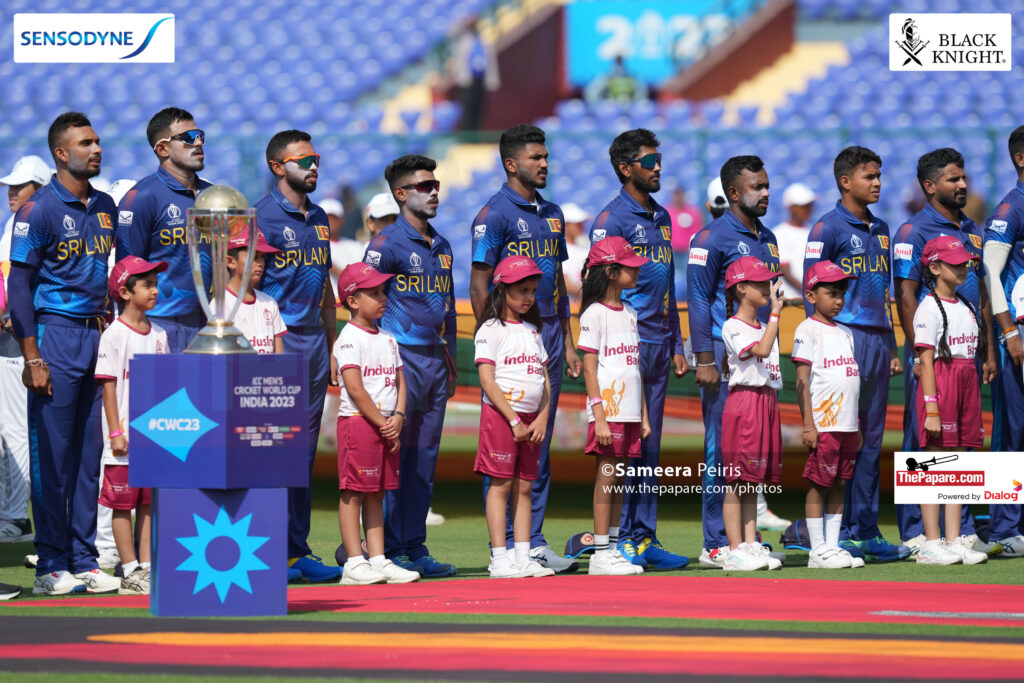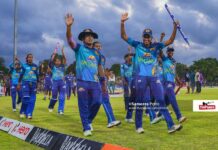Sri Lanka Cricket’s consultant coach Mahela Jayawardene in an exclusive 16-question interview during the ICC Men’s Cricket World Cup 2023, shared his thoughts on the current campaign in India, future plans for Sri Lanka Cricket and the progress of the High-Performance program set in place with ThePapare.com.
Reporting from Lucknow, India
Two losses so far in the competition, and seven more games to go. How do you see Sri Lanka’s prospects?
Yeah, I think you always want to have a positive start in a World Cup. We came across South Africa, which was a strong side and they were playing some really good cricket at the start of the tournament. Especially on that Delhi wicket, on a small ground that was a bit of a disappointment the way it went but you have to take into account that we were beaten by a better team on that day.
A bit more disappointed with the Pakistan game where we were playing positive cricket, which we’ve asked the guys to play at the start of the tournament because that is the tempo that we need to play in this World Cup given the wickets in India and how the tournament was going.
Sometimes they’re not used to it [positive cricket] but we had to take that kind of approach, especially with a weakened bowling attack. So that’s what we were planning but it was disappointing that we couldn’t defend that score [344]. We didn’t have the discipline with the ball, especially in the areas where we wanted to ball and protect the short boundary which we did not do. And at the same time, I think you know, the fielding also, we probably need to have much more energy out there. I think in both the games, maybe because of the way we were bowling it got depleted but I think we’re a much better fielding unit than that.
So, these are the areas that we need to improve. Like I said, you know, would have been great to at least have one win under our belt at the beginning of the tournament and have that kind of momentum, but it’s a long tournament. So we need to think positively. We don’t know how the rest of the matches are going to go with the other teams. So we need to control what we can control which is by winning a couple of crucial games and then getting ourselves into that – 50% mark which is five wins in a tournament so that you know you’re giving yourself a chance for that semi-final spot.
In terms of the batting combination, during the Qualifiers, Dimuth opened the batting and here, we have Kusal Perera and he’s not firing. Do you think there’s a problem with our combination?
I think what happened was obviously Kusal [Perera] went to New Zealand, played really well, and then got injured again. So that was when we decided to go with Dimuth, bringing him back, where we need a bit more stability in that Qualifier, especially given the wickets that we were playing day matches in Zimbabwe. Tactically it paid off, Dimuth was good so we knew that we could fall back on Dimuth whatever the situation was. So even in the warm-up games, I think Kusal did bat well. But, unfortunately in the first two games, he looked off-base and off-color. So that’s something that we will have to think about.
But obviously having Dimuth, an experienced batter in our squad makes for us because that was a particular spot that we all knew that we needed to have two options going into the tournament because you can’t have too many options. But we knew that we could still use Kusal as a floater in different positions in that lineup because he has the power and he plays spin well. So that was the thinking behind it because you can’t have too many reserves. Only one extra batting reserve we could keep so that was the plan. So, yes, like you rightly said, Dimuth is an option, having looked at the South Africa vs Australia game, and how that wicket played, we have a few days to think about before we make a decision.
The lower middle order of No. 5, 6, and 7 not scoring runs in the recent past, especially Dhananjaya De Silva and Dasun Shanaka. Even during the Hyderabad game, they did not score runs as quickly as possible. How do you see this situation?
Well, it’s tough because in every game the situations are different. I mean, Charith [Asalanka] has been very good for us for quite some time. He is probably one of our most consistent players. And yes, he got a decent ball and that can happen after a big partnership.
DDS [Dhananjaya De Silva] is someone that we always bank on like when we had those collapses throughout the last 12 months. You know, he’s been one guy who’s you know, managed to lift his game up and rescue us from those situations. Yes, he might not have the power game that we wanted, but he still can hit the gaps, and create that opportunity. We need stability so that was the whole reason that we had those guys. Yeah, we lost a little bit of momentum in the Pakistan game. Dasun also didn’t get runs but he did get a good knock against South Africa. Ideally, you want all those elements to fire in those kinds of situations and give us what we want.
But Cricket is a game that you know, sometimes it doesn’t work out always but I think we can’t be disappointed with the 345-350 mark, putting runs on the board on a slowish pitch in Hyderabad. We could have easily put pressure on that Pakistani lineup but it’s just we lacked discipline in our bowling.
As long as we can keep this tempo that we were playing, and everyone buys into that and play without fear then one component of our game gets more consistent and then we need to work on the bowling and we knew that coming into the tournament that it is a depleted lineup, especially when you don’t have Wanindu and Dushmantha, two experienced bowlers who’ve done well for us. Especially Wanindu because he and Maheesh always used to control things. Maheesh coming back from injury is a positive but other elements in that attack are something that we need to sort out, that’s where the concerns are.
Playing in turning pitches in Sri Lanka during the LPL and Asia Cup, is it ideal preparation coming into the World Cup considering most pitches in India are flat pitches?
Well, I think it’s tough to say that we will get flat wickets throughout the tournament, I think at the beginning of the tournament, you will get some, and then during the course of the tournament, the pitches will get slower. That’s my take on it. The pitch in Lucknow was on the slow side and it turned and in Chennai also, you had a turner. I thought even Hyderabad was a slowish wicket even though both teams batted well. So, I don’t see it’s flat, I mean Delhi was flat but that can be a one-off.
The thing is sometimes we have to play to our strengths if we want to win tournaments at home and ranking points and all that as well. That’s a strategy that we’ve used and the guys have to adapt to different conditions. We had a couple of good games in Guwahati, which were decent wickets. But, that’s where we asked them to up the tempo and all that and play to that. They went to New Zealand and played in good wickets, even in Harare, it was a good wicket. We had some really good tracks in Bulawayo during the Qualifiers and all that. So it’s harder for me to argue positively on that comment because I think a modern-day cricketer should be able to adapt to all conditions and play to those different tempos. And that’s a challenge that you have as a player. I mean, yes, we can always prepare wickets.
I mean, in our Domestic Club Tournament is something that we don’t have control of because the Clubs do play to their strengths and all that. So, the NSL Tournament is something that is in our control, which we started last year, and we played on good wickets. This season also, what we are planning is to play in our main stadiums on good wickets so that bowlers, batters, and everyone get challenged on those conditions. But that is a process that just started last year and that’ll take some time to adapt and, you know, get everyone to play in those conditions and see how it is. We’re going to have more games as well this year in the NSL. So that’s part of a long-term plan as part of the development.
Anyway, that cannot be an excuse. I mean, why would a batsman complain? I had a chat with Sadeera on this as well. But, I mean it’s fair enough that he said something in that situation because he’s pretty new to the setup and he probably wouldn’t have experienced this. And it was a challenge for them. So that was a conversation we had and said okay, now we need to adapt to these conditions and this is the tempo that we need to play.
I was quite happy with the tempo the guys have been going with especially skill-wise, you know how we evolved over the last six months. But we still have to improve, we can’t be where we are as a unit, as a team, we need to keep lifting ourselves up. I see potential in this group purely because of the fact that they’re all young. They’ve got at least another one if they stay fit, another two World Cups under their belt. So that means we have the same group and we can keep adding new talent to that. So that’s a very good positive for us going forward.
Is there a skill-gap with the Sri Lanka team when you compare with the other more experienced teams?
Yes, I mean, in any World Cup or any World Cup cycle that is always going to be there. I mean, if you look at India, they won a World Cup in 2011. For 12 years, they haven’t won a World Cup. England had to wait for 30-odd years to win a World Cup and that group is together. Australia had two or three successful World Cups since then they haven’t been able to hit the mark. Because once you invest in younger players or groups, it takes a bit of time for them to get together and play. And Pakistan hasn’t won a 50-over World Cup for a long time.
In every team, even though they have talent, for them to gel together and all that, there’ll be issues and different skill sets with experience. That’s a combination that you’re looking at – the right experience and the skill set.
So that’s what we’ve invested two years ago. This group, they played two T20 World Cups together and this is their first 50-over World Cup. We had seven guys who played their first 50-over World Cup game. Unfortunately, I mean, we did not plan for guys like Wellalage and Matheesha to have big roles in this World Cup. We wanted them to come into the squad and be part of the experience so that they would be played in certain situations only.
Wanindu and Dushmantha would have been the two main guys so then we would have had a great attack. Dilshan has come a long way as a left-arm fast bowler and we’re very happy to have him because he’s a brilliant skilled bowler. I see a lot of potential in him because he’s still raw. But every day, he’s learning and he’s a quick learner. If we can keep this group together, we will have the right component.
I feel Championships are won with Bowling, not so much with Batting. Bowling is the most important element of winning championships. So you need to build that Bowling unit. So that’s the path that we’ve taken. Hopefully, we keep all these guys fit and healthy going forward.
To answer your question, yes, Skill and Experience. I think skill-wise, we’re not that far but because of the experience part, yes.
But, saying that, if you just bring experienced players without skill to adapt to the modern-day game, it will not work so we had to have that right balance. It’s a plan that the selectors made two years ago, and I also backed that plan because then we have some direction in where we’re heading with this because you can’t be in limbo.
Yes, it might be tough sometimes for us, but I think this group has shown that they have the potential, winning an Asia Cup in the T20 format, getting into an Asia Cup final in the 50-over format because we had to play two strong teams in Pakistan and India. In the last two T20 World Cups, I was a part of the team. We missed those semi-finals by one game. It was just one win, we’ve missed out against South Africa in the UAE and then against New Zealand in Sydney. So those are the two games that we should have won and otherwise, we would have been in the semi-finals. So we are close. But we just need to make sure that we back these guys and get them over the line.
All modern-day cricket teams have plenty of power players. But Sri Lanka were not known to have such big-hitting players apart of few. Can we change that or stick to what we are known for?
If we can have power players will be good at least one or two. But, like you rightly said, we’ve never had that. So, what we had was, we adapted to those with the skill set that we had – hitting gaps and being more aggressive. Sometimes you can score at a higher strike rate if you have the skill set to hit those gaps rather than a power player because the power players will also struggle on slow wickets but on good wickets, yes, they will score runs. So, it’s a combination of both.
Ideally, if you can produce a couple of power players and be consistent with that type of tool, it will be brilliant. But, if we don’t have power players, then we still have to adapt and play at a higher tempo so that whatever the runs that we might miss from over no. 40 to 50, we’re capitalizing in the middle overs with that extra fielder up in the circle. Ideally, in the last 60 balls, you should be able to score 80,90 and 100 runs. However, we missed out because we lost wickets otherwise, which we should have got it. It’s not impossible.
Going forward, I still feel if we play the Brand of Cricket that Sri Lanka played all along and keep improving and evolving on that brand, then we are fine. But, if you have power players coming through the junior ranks and in the next level, yes, we will definitely use it.
Thisara came through, Angelo when he started, we used him in a similar role, but Thisara is the one we had in my memory, who was a power player, suited for that no.7/8 role. In 2007, we had a skinny version of Russell Arnold and TM Dilshan who were still taken into those roles. In 2011/2012, we had Kapugedara, who had power, but consistency wasn’t there. Then Thisara came in that time of the T20 version.
The teams will keep on evolving. Not all the teams will have power. Take South Africa, some of those guys will be finishing after this World Cup, so then whether they will have the same kind of guys coming through we don’t know. India is also a part of Hardik Pandya, there is no other power hitter but what they do is they go really hard at the top and they capitalize on that. New Zealand also doesn’t have power, Neesham and Philips were there but they also found a way to capitalize up front. So, people can approach things differently and play to their strengths rather than trying to emulate something which it’s difficult for us to consistently maintain.
With the amount of T20 cricket being played these days, are we not focusing on improving their power-hitting?
You can, but it is also a skill. I mean it’s a technique that you need to work on. Power-hitting is not about hitting the ball hard, it’s about having a great bae, using your whole extension, and hitting good areas. In Modern-day cricket, the longest boundary will be 75 meters, anyone can clear that, and it’s not that difficult. But it’s about picking those areas and hitting and evolving as cricketers.
In Modern-day cricket, most of the subcontinent players, I would say 70%, don’t sweep the ball. But all the other players from other SENA countries are sweeping. They are sweeping and reverse sweeping because they’ve been taught to play that way in the subcontinent. Our guys are saying, we’ve been brought up in the subcontinent, so we need to challenge ourselves to play on faster, bouncy wickets, which I think our guys are playing better because we’ve trained ourselves but they’ve forgotten how to play in these wickets, now, especially with the extra fielder, we don’t find guys who are sweeping.
I have thrown the challenge to our boys – you have easy boundaries, easy options if you’re doing this and that’s something that they need to get better at.
If I didn’t sweep, I probably wouldn’t have got half of my runs which I have scored. As I said, there are still options for our guys to get better and achieve more by just adapting to these things. You don’t need the power, It’s about maneuvering the bowlers around the field. So, it’s not just a Sri Lankan thing, but I’ve seen India and Pakistan. Except for a few guys, most guys don’t sweep. So, it’s very difficult for you to take control of those middle-overs when you’re not sweeping, especially the spinners.
So, there are areas where we can improve as a team. And that’s something that I have put in place in the High-Performance Center, where all the players coming through will be challenged to play different areas so that it’s not going to be a surprise for them when they play in Australia or worse conditions in Chennai or wherever that you know you have the skill set to do that. I feel that all subcontinent players for the last 10 years or so have thought that I should be able to play spin just because I’m from the subcontinent, but it isn’t. You have to still work on it. I see we are losing a lot of runs because we are not still good at it.
You have been appointed as Consultant Coach for two years now and we’ve seen some consistency in coaching and selection. How do you assess your journey? Are we on the right process?
I can’t take credit for that. I mean, this is the Technical Advisory Committee that put all this in place and I was also involved with Aravinda, Sanga, Roshan, and Murali. There was a document that we put across and they wanted me to get involved in executing, that is why I’ve gotten involved doing that.
I think we’ve put things in place now. There’s a structure in place, and anyone can come and see what we’re doing. Visibility is there when it comes to the Under 19 program, the Provincial and District Tournament, and how this selection is being done. What are the skill sets that we’re looking for in a player? We have an Emerging team, which is Under 23/24. They’ve had two tours already. So, we’re putting together a plan that all those age groups are touring Home and Away, to have at least 3 or 4 tours every year because they have to play cricket in different conditions and then we have the ‘A’ team and we have the national team.
Everyone is going through the High-Performance program. There are about 65-67 players that we’ve identified who have been put through the High-Performance program so each of the coaches is dedicated to these players with bowlers and batters given slots throughout the week. Even though they have club matches, they still need to come and do their specialized one-on-one sessions.
We are putting across a separate Fast Bowling group and Spin group in our next phase because we feel that we need to run those two programs. We feel that the Strength and Conditioning and the Bowling Fitness of some of our bowlers are not there and that’s where the injuries are happening.
So we need to put a system in place at a young age where we put them into that group so they have been monitored through their workloads and monitor bowling fitness and all that. It’s a minimum requirement in any High-Performance program, especially in a national program. If we can consistently keep this going for five years, we will definitely see results.
It doesn’t matter who’s coming and who’s going to be there or not. But, as long as people don’t just come and ad-hoc change these things, they definitely can improve on it. But should not change because these things have to be there for any program to work.
The Under 19 group that finished in 2022, those players have come a long way. Wellalage and Matheesha are already in the national setup and the likes of Shevon Daniel and a few more others will play for Sri Lanka pretty soon. So those guys will come through. And if we can keep producing that kind of caliber and get them fast-tracked into the system, that’s the way forward.
Club cricket has to be there, but club cricket will not produce the modern-day cricketer that we require because of the conditions and the quality of cricket that’s being played. So, that’s where NSL will come into play where we can identify the good players in good conditions.
We have a lot of spinners who are undercutting the ball because they’re used to it, and it’s better suited for them. They don’t have the topspin, the bounce, and all that because they don’t need to do that on our wickets. It’s harder for someone who’s grown up undercutting the ball to come up with a higher-arm and get the topspin into play. We have produced cricketers to suit our wickets not for good wickets, so the bowling skill is completely different. So these are little things that we need to work but it will take some time.
Wellalage is in the process of trying to get his arm a little over the top so that he can get some bounce because he’s anyways short and if he doesn’t do that, he’s not going to be good on batter-friendly wickets. So he has to start learning to get more bounce and spin by bowling with the arm over the top because he’s used to just darting it.
It’s the same with the batsmen, bowlers, the fitness, everything will come into play. We’ve got a policy in our High-Performance with fitness. I know we’re pushing guys harder but that’s a requirement in Modern-day cricket. If they don’t do that, Mental Fatigue and Injuries will happen and they won’t be consistent at the top level.
Otherwise, we can happily say you can’t go and play this league and you can go play that. But you have to allow them to go and play these leagues because they’re going to get experience through that. But if they’re to do that, then they must be fit. Otherwise, you will break down, because it’s two or three week tournaments that they’re playing and it happens so quickly. Also, you jump from a different format to other formats as well so that’s going to be hard work. In those 10 or 12 years of their careers, that discipline has to be there.
Are we really pushing the ‘Fitness Regime’ to the players because recently we’ve seen plenty of injuries?
It is alarming, but they also understand that they’ve let themselves go and if they do that, it’s their own fault because then they will get injured, and it has happened. So it’s a good lesson and it’s a culture change as well. I mean, we only started this fitness thing about a year and a half ago. And there’s a lot of opposition to that as well. But now, I think little by little, they also have realized that it has to happen because they can’t compete at that level and be fit we might not be able to change every player but if we can start with the younger groups and the development squads and all that, at least we can create a culture.
For the first time, we have got a Nutritionist working full-time with all the national players, and club players as well. We’ve got a Sports Psychologist too, a Sri Lankan guy, we’re trying to get him full-time but he’s still not full-time with us but he’s had quite a few sessions with the player. So these are aspects that you need to improve.
Technology-wise, we’ve managed to get all the modern-day analysis, and all the software done. We’re getting the new Catapult, which is arriving, I’m bringing it back when I go next week. It just arrived in Colombo, which is the new GPRS system so that you can monitor a lot of things not just the volume of players but we can check the heart rate monitors and there are sensors which you can evolve in the fatigue levels of certain muscles and those things also can be monitored, which then gives you data on where the players are players. So then, if they need a break or not, kind of thing, that we haven’t done for so many years. Some of the franchise teams are at AI (Artificial Intelligence) now.
Yeah, we’re so far behind on all that but at least we are starting which is a positive thing and people are listening that we need this. We just keep on improving on these things and get the right people involved who understand that as well. I mean, that’s the challenge that we have with coaches and everyone who needs to be involved, they need to have those qualifications, the intelligence to run this. You can’t just come in and do that because if not then it won’t tally together, but we’re trying to do what we need to do.
Is there a vacuum with potential leaders in the system?
Yeah, I mean these are all that need to be planned in advance and identify those individuals and give them more responsibility at a young age. So that’s something that we’ve discussed and now we’re going to move on.
I wasn’t involved at that time when we had a lot of issues in the team from 2016 to 2019. Afterward, obviously, we had to get the team together and that’s when the selectors at that time made a decision with the leadership and how they wanted to take that direction, I think it has paid off for that period. But like you rightly said, going forward, we need to think about how we are going to grow the next generation of leaders and build teams around that and have that consistency. That’s the big word for me – consistency, like you rightly said about selection processes, and planning and everything has to be consistent, has to tally and accountability has to be there. The problem that we have is if we keep changing selectors or people who are making decisions every two years or three years, you’re not going to get that consistency.
If a different mindset comes in and then they keep changing, then that is going to be a problem. So that’s where whoever makes those decisions has to understand that continuity has to be there, that consistency has to be there. It should be like a national policy.
This is the plan. This is how we’re going to play cricket. This is the group, this is the investment we made. You’re not going to win an Olympic medal by just going into the Olympics straight away. You have to plan for 10 years to win an Olympic medal with someone, you have to spend money on that person, and you have to invest in that plan. So for us to win another World Cup, we have to plan, we have to build to win a World Cup, it’s not going to just come like that.
I mean apart from Australia who won three World Cups in a row in 1999, 2003, and 2007, no other team has been able to achieve that. So that means that you have to spend time on building teams, giving that experience getting the skill set, adding the missing pieces in between, and winning a World Cup. You can’t just turn up and win World Cups. You might be lucky if that happens, but you can’t do everything for luck, right? So you need to have a plan and consistency, continuity is the key, which I feel and hopefully going forward we will have that at that decision-making level, especially when it comes to the cricketing side of it.
Who are the players that we’re pushing through? Who are the ones we are fast-tracking? Because some players will develop when they’re 26 or 27 and they will be more useful for us in another World Cup four-year cycle, we don’t know that. Some players who we haven’t even thought about, might all of a sudden, be very valuable. So we can say no, we’re not going to look at those guys. No, there might be a 30-year-old, who will be good for us in the next World Cup four-year cycle. So we have to keep our minds open and keep developing these guys so that they will then come in and fill in those holes that we need to fill in. So it’s that continuity and consistency that we have to maintain.
Selecting the captain first rather than selecting the team first, is it the right thing to do?
I always feel that the captain is a player first. Yes, in the recent past, obviously we had to go through because of the combinations and whatever we wanted to achieve is too close to a World Cup for us to make those kinds of big decisions. Unfortunately, Dasun went through a pretty lean period. Otherwise, he’s a fabulous player for us and the skill set that he has is quite unique and rare to find that. The other thing is you don’t want to burden your best players with those leadership roles if they’re not ready to pay combat as well. So that’s where you need to identify the right guys who can manage it, who have a voice in the dressing room, who have that command to be able to do that. So that identification has to happen and then build on that.
It might not be just one player, it might be two or three players and then at that point, you can decide on how we’re going to go about it. But all in all, that has to be part of the whole Master Plan that you have on continuity. We started planning after the last T20 World Cup on how we’re going to play the next T20 World Cup in 2024 and that plan has been in place. We know exactly how we’re going to move on and what changes we’re going to make and all that has already been put in place. We didn’t want to do that because we were focusing on the 50-over World Cup.
Unfortunately, we didn’t have a genuine plan after the 2019 World Cup, for how we were going to play in 2023, that’s where the problem was.
Yes, COVID happened as well, we hardly played any 50-over cricket. Investment of players and all that was also not there.
When this program started, we had two T20 World Cups in two years. So the entire focus and everything was on getting this team together and fitting into that and then those players were the ones that been majority use for the 50-over World Cup as well.
So my advice was that wherever it is, we can’t control that. Play this World Cup positively and give ourselves our best chance to get into the semi-finals and try and win it. But if not, soon after this is finished, we need to plan for the next cycle and then have a proper plan in place. What are the pieces we need? And who are the players and then invest in those players, give them the exposure, give them the experience and game time.
Because for every World Cup, you need guys to have played at least 30 to 40 ODIs minimum. So that’s like 10 or 15 ODIs every year. That’s the kind of experience you need. When we went into World Cups, the guys we had, the experience was 350 to 400 ODIs, 350, that’s the level that you’re talking about. And that’s a difference.
Kusal Mendis has come a long way, especially since the Durham incident to perform consistently. Your thoughts?
I’ve always felt that Kusal was always a very special player from younger days. And even when everyone was doubting his ability and all that, I’ve said that we need to invest in him. Any player will make mistakes and whatever, but I think he’s grown very quickly, matured, he understands.
The best thing about him is that he’s managed to block all the other elements in the last few years. That’s been his strength and he’s learned how to do that and just focus on his game and how he wants to play cricket and we’ve encouraged him to play the brand that he wants to play without getting him to play something else. If we can build a team around that, and the others will also have the confidence of playing that kind of brand. And there are a few other players that we’ve now put in place around that, who will play and complement that. So then we can keep on evolving. And that’s where the next generation of players we’ve identified who are coming through now will also assist to do the same. So that we have guys complementing each other and not putting each other under pressure. So they will understand that brand.
What are the strengths you’ve seen of Kusal Mendis?
I think just the skill set, the areas where he’s playing. The base he’s playing with. He’s a good player of fast bowling. Anyone who can pull, or cut as an option is rare. Initially, he will struggle when the ball is moving, but any good batsman will probably have his moments when the ball is moving. So once it gets over that he’s got a good base to play with.
And he’s a decent player of spin. I still challenge him I think he can still get better playing spin. He’s still not at full potential in how he goes about playing spin. But he can definitely improve on that. But it’s just the mindset and the tempo that he’s playing. I mean, he can destroy an attack if he wants to at any given time and he has the, not the power, but it’s just the timing and the skill to hit different pockets in the ground. Now, he’s developing into a modern-day cricketer, which we want everyone else to challenge themselves.
Has there been any changes to his batting style?
We’ve worked a little bit on his technical stuff and all that. Aligning to different bowlers and wherever he had issues he’s kept working on that. But it’s also part of you growing in confidence, in being able to play the game you want to play as well. I think now he’s gotten to where the consistency comes about, scoring runs in three formats.
He’s playing a similar tempo, he’s adjusting to conditions, bowlers, and all that. He’s still 28, so there’s a long way for him to go and I’m hoping that we haven’t seen the best of him yet. He also must understand that he can’t be complacent, he has to still keep on evolving and getting better because you will go through periods where you might not score runs and all that, how you’re going to handle those moments and how you’re going to evolve. Teams will start to analyze him and see how they can get him out and which areas he can be bowled to, so he has to keep improving on that.
Many predict that 50-over cricket, the bilateral cricket will have a slow demise. Where do you stand on bilateral cricket, especially 50-over cricket?
I think there is still room for bilateral cricket. I’m of the view that we need to reduce bilateral T20Is. Because they’ll be playing enough and more leagues that are happening and everyone is playing T20 cricket. All your main players are playing somewhere or the other so you could need to only get together on a T20 World Cup year for six months. Where you don’t play is 50-over Cricket, because you can’t just show up on a 50-over year and play 50-over cricket because it’s a different tempo and a different way that you play 50-over cricket, so you need to adjust to that.
So, my take on that is to reduce bilateral T20I cricket, but obviously, I know the economics don’t agree with that. Boards want to have more T20I cricket but the only way we can have that structure is by reducing T20I cricket and having a minimum of three ODIs played in a bilateral series.
3 Test matches 3 ODIs, and 1 T20I game, would be a good bilateral rather than having three T20Is. And by doing that you always reduce a Test match and that is not healthy as well. So ideally 3 Test matches 3 ODIs, and 1 T20I game would be a pretty decent bilateral series.
Since you’ve been heavily involved with franchise cricket. Do you see Cricket adapting the Football style in the near future, where the players represent their clubs but, do not represent their country for international games apart from the Qualifiers and World Cup?
I think it will be a Hybrid of both. Already, the global franchise cricket has evolved. Consistently there are eight leagues happening throughout the year, and pretty much every month there’s a franchise league. So you will have certain players who might be playing T20 leagues only, the specialist players, who are finishing their career or at that level. When they go and play the domestic T20 franchise league, the domestic players will also benefit from them. So like in the LPL, where our guys got good experience playing with some international players, so for each country that benefit will be there.
But it will be a Hybrid where you will see a reduction of bilateral series. The FTP has already been drawn up to 2027. So after that, we’ll have to see how much bilateral series will happen. But, with the ICC World Test Championship, there’s a minimum amount of Test Cricket has to be played. 50-over Cricket will need to have that adaptation as well at some point. But, it’ll be a Hybrid because I don’t see it going the football route it’s been there for many years. The football clubs are the center of everything and then playing the FIFA World Cup, you’re getting the friendlies and stuff like that. It’s just an offshoot.
Whereas the cricket has come the other way. So it’s very difficult for you to detach from them. If you don’t see the Indian team playing together as India, this country will go mad. Pakistan as Pakistan. No one’s going to accept the franchise the way they’ve accepted their country. Australia is the same, and England is the same. So, I don’t see that happening in cricket.

